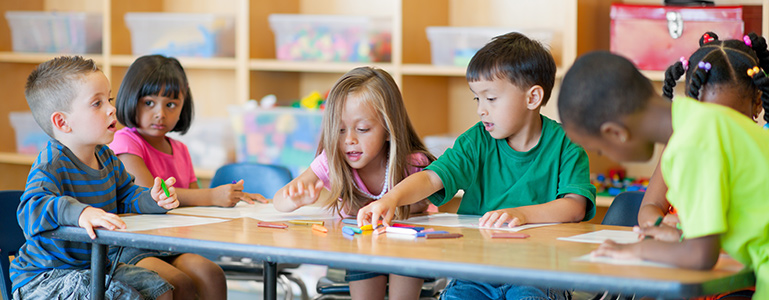In this special series about Parenting and Race, we highlight the experience of what it’s like to raise kids of color in our society. The intention is to spark courageous conversations, encourage reflection, and provide guidance and support for talking to kids about race and racism at every age, so we can create more inclusive, respectful, and socially just communities.
How do we support families and teachers to do anti-bias and anti-racist work beginning in preschool?
Let’s start with a meaningful children’s book called The Crayon Box That Talked by Shane Derolf. The story begins with the multi-colored crayons arguing with comments like, “I don’t like you and I don’t know why.” A little girl overhears them, buys the crayons, and begins to create a picture using the different colors. The crayons begin to see how beautiful they can be together.
Teachers work hard to create classroom communities where every child and family is valued, regardless of color, shape, size, and ability. Similar to the little girl in the story, the goal in preschool is to recognize the importance of every individual when creating a school community.
As an experienced, confident African-American teacher and educator, I strive to ensure that my students know that I care about who they are and who they will become. I look beyond the color of their skin to see a unique child, working hard to build the physical, social, and emotional skills they will need to thrive.
Children, families, and teachers of color want to be loved and recognized for the human beings we are. I’m a person first. I encourage my fellow educators to not fear difference, but embrace it. Being open to people of different backgrounds might make us feel vulnerable at times, but the reward of building respect and acceptance is worth the effort.
As Martin Luther King, Jr. so eloquently stated in 1963:
“I have a dream that my four little children will one day live in a nation where they will not be judged by the color of their skin but by the content of their character. I have a dream today.”
Here are some tips and strategies to support teachers and families in preschool/childcare as you work to create inclusive, socially just classrooms:
For Teachers:
- Create a classroom community instead of a classroom: A high-functioning, supportive classroom community is one in which everyone is welcome. One way to highlight family diversity is to prominently display photos of each family.
- Celebrate each family: Invite families into the classroom to share something personal about their family experience. One example might be to share a special dish or a children’s book. Invite the child or parents to share why this tradition is important to them.
- Be brave! Talk about differences within the classroom community and allow for any questions that may come from the children. Acknowledge diversity, and remind everyone how important each person is to this school community.
- Bring diversity into your reading materials. Ensure that there are children’s books in the classroom representing the cultures of the families in the school and people in the larger community.
- Include children as you discuss and set expectations for the classroom community. This process builds children’s confidence, ensures each classroom citizen has a voice, and is a useful way to check in with children when those expectations are tested.
For Families:
- Be open to sharing more about your family by offering to bring in a special dish, read a children’s book, or highlight some other aspect of your home culture to enrich the classroom community.
- Connect regularly with your children to show how important they are in this world. Use positive comments like, “Thank you for helping the teacher set up for snack today—she told me it was very helpful.” The more children hear positive feedback, the more positive things you will see. Create a special time to listen to your child when they talk about their day.
- Read with your child daily. Choose books that celebrate different cultures and people. This expands their worldview and builds a strong foundation for literacy. It is also a wonderful bonding experience for you and your child.
These resources can guide you in this critical work:
The Crayon Box That Talked by Shane DeRolf
16 Ways to Help Children Become Thoughtful, Informed, and Brave About Race
Activities that Promote Racial and Cultural Awareness
7 Ways to Support the Young Activist in Your Life
Guide for Selecting Anti-Bias Children’s Books
These Books can Help You Explain Racism and Protest to Your Kids
Beyond the Golden Rule: A Parent’s Guide to Preventing and Responding to Prejudice
Teaching for Change: Teaching Young Children About Race
How to Talk About Race: Books and Resources That Can Help
A White Families’ Guide for Talking About Racism
By Shalek Chappill-Nichols, MS
Shalek Chappill-Nichols, M.S., is a Parent Educator at JFCS’ Center for Children and Youth, and provides professional development and learning for teachers and parents in the areas of mathematics, science, art, literacy, and social-emotional learning. Shalek creates and delivers classroom activities, in-service trainings, seminars and workshops, conferences and curriculum materials, and resources to preschool through high school educators throughout the State of California. For more than 20 years, Shalek has supported educators to integrate technology and social-emotional learning into the classroom, to bring the California State Standards to life in their practice, and to help students learn to think creatively and critically in all educational domains.



